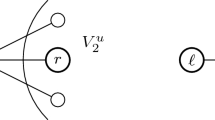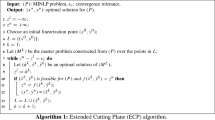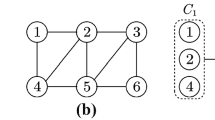Abstract
We present a method for finding exact solutions of Max-Cut, the problem of finding a cut of maximum weight in a weighted graph. We use a Branch-and-Bound setting that applies a dynamic version of the bundle method as bounding procedure. This approach uses Lagrangian duality to obtain a “nearly optimal” solution of the basic semidefinite Max-Cut relaxation, strengthened by triangle inequalities. The expensive part of our bounding procedure is solving the basic semidefinite relaxation of the Max-Cut problem, which has to be done several times during the bounding process. We review other solution approaches and compare the numerical results with our method. We also extend our experiments to instances of unconstrained quadratic 0–1 optimization and to instances of the graph equipartition problem. The experiments show that our method nearly always outperforms all other approaches. In particular, for dense graphs, where linear programming-based methods fail, our method performs very well. Exact solutions are obtained in a reasonable time for any instance of size up to n = 100, independent of the density. For some problems of special structure we can solve even larger problem classes. We could prove optimality for several problems of the literature where, to the best of our knowledge, no other method is able to do so.
Similar content being viewed by others
References
Achterberg, T.: Constraint integer programming. PhD thesis, Technische Universität Berlin. http://opus.kobv.de/tuberlin/volltexte/2007/1611/ (2007)
Achterberg T., Koch T., Martin A.: Branching rules revisited. Oper. Res. Lett. 33(1), 42–54 (2005)
Armbruster, M.: Branch-and-Cut for a semidefinite relaxation of the minimum bisection problem. PhD thesis, University of Technology Chemnitz (2007)
Barahona F., Ladányi L.: Branch and cut based on the volume algorithm: Steiner trees in graphs and max-cut. RAIRO Oper. Res. 40(1), 53–73 (2006)
Barahona F., Mahjoub A.R.: On the cut polytope. Math. Program. 36(2), 157–173 (1986)
Barahona F., Jünger M., Reinelt G.: Experiments in quadratic 0–1 programming. Math. Program. 44(2, (Ser. A)), 127–137 (1989)
Beasley J.E.: Or-library: distributing test problems by electronic mail. J. Oper. Res. Soc. 41(11), 1069–1072 (1990)
Beasley, J.E.: Or-library. http://people.brunel.ac.uk/~mastjjb/jeb/info.html (1990)
Beasley, J.E.: Heuristic algorithms for the unconstrained binary quadratic programming problem. Technical report, The Management School, Imperial College, London SW7 2AZ, England (1998)
Benson, S.J., Ye, Y., Zhang, X.: Solving large-scale sparse semidefinite programs for combinatorial optimization. SIAM J. Optim. 10(2), 443–461 (2000, electronic)
Billionnet A., Elloumi S.: Using a mixed integer quadratic programming solver for the unconstrained quadratic 0–1 problem. Math. Program. 109(1, Ser. A), 55–68 (2007)
Boros, E., Hammer, P.L., Tavares, G.: The pseudo-boolean optimization. http://rutcor.rutgers.edu/~pbo/ (2005)
Boros E., Hammer P.L., Sun R., Tavares G.: A max-flow approach to improved lower bounds for quadratic unconstrained binary optimization (QUBO). Discrete Optim. 5(2), 501–529 (2008)
Burer, S., Monteiro, R.D., Zhang, Y.: Rank-two relaxation heuristics for max-cut and other binary quadratic programs. SIAM J. Optim. 12(2), 503–521 (2001/2002, electronic)
De Simone C., Diehl M., Jünger M., Mutzel P., Reinelt G., Rinaldi G.: Exact ground states of Ising spin glasses: new experimental results with a branch-and-cut algorithm. J. Stat. Phys. 80(1–2), 487–496 (1995)
Delorme C., Poljak S.: Laplacian eigenvalues and the maximum cut problem. Math. Program. 62(3, Ser. A), 557–574 (1993)
Deza M.M., Laurent M.: Geometry of Cuts and Metrics. In: Algorithms and Combinatorics, vol. 15. Springer, Berlin (1997)
Elf, M., Gutwenger, C., Jünger, M., Rinaldi, G.: Branch-and-Cut Algorithms for Combinatorial Optimization and Their Implementation in ABACUS. In: Lecture Notes in Computer Science, vol. 2241, pp. 157–222. Springer, Heidelberg (2001)
Fischer I., Gruber G., Rendl F., Sotirov R.: Computational experience with a bundle approach for semidefinite cutting plane relaxations of Max-Cut and equipartition. Math. Program. 105(2–3, Ser. B), 451–469 (2006)
Frangioni A., Lodi A., Rinaldi G.: New approaches for optimizing over the semimetric polytope. Math. Program. 104(2–3, Ser. B), 375–388 (2005)
Glover F., Kochenberger G., Alidaee B.: Adaptative memory tabu search for binary quadratic programs. Manage. Sci. 44(3), 336–345 (1998)
Goemans, M.X., Williamson, D.P.: .878-approximation algorithms for max cut and max 2sat. In: Proceedings of the Twenty-Sixth Annual ACM Symposium on the Theory of Computing, pp. 422–431. Montreal, Quebec, Canada (1994)
Goemans, M.X., Williamson, D.P.: Improved approximation algorithms for maximum cut and satisfiability problems using semidefinite programming. J. Assoc. Comput. Mach. 42(6), 1115–1145 (1995, preliminary version see [22]
Hansen P.: Methods of nonlinear 0–1 programming. Ann. Discrete Math. 5, 53–70 (1979)
Helmberg, C.: Fixing variables in semidefinite relaxations. SIAM J. Matrix Anal. Appl. 21(3), 952–969 (2000, electronic)
Helmberg, C.: A cutting plane algorithm for large scale semidefinite relaxations. In: The Sharpest Cut, MPS/SIAM Ser. Optim., pp. 233–256. SIAM, Philadelphia, PA (2004)
Helmberg C., Rendl F.: Solving quadratic (0,1)-problems by semidefinite programs and cutting planes. Math. Program. 82(3, Ser. A), 291–315 (1998)
Helmberg C., Rendl F., Vanderbei R.J., Wolkowicz H.: An interior-point method for semidefinite programming. SIAM J. Optim. 6(2), 342–361 (1996)
Johnson D.S., Aragon C.R., McGeoch L.A., Schevon C.: Optimization by simulated annealing: an experimental evaluation. part i, graph partitioning. Oper. Res. 37(6), 865–892 (1989)
Jünger, M., Reinelt, G., Rinaldi, G.: Lifting and separation procedures for the cut polytope. Technical report, Universität zu Köln (2006, in preparation)
Karisch, S.E., Rendl, F.: Semidefinite programming and graph equipartition. In: Topics in semidefinite and interior-point methods (Toronto, ON, 1996). In: Fields Inst. Commun., vol. 18, pp. 77–95. American Mathematical Society, Providence (1998)
Kim S., Kojima M.: Second order cone programming relaxation of nonconvex quadratic optimization problems. Optim. Methods Softw. 15(3-4), 201–224 (2001)
Laurent M.: The max-cut problem. In: Dell’Amico, M., Maffioli, F., Martello, S.(eds) Annotated Bibliographies in Combinatorial Optimization, pp. 241–259. Wiley, Chichester (1997)
Liers, F.: Contributions to determining exact ground-states of Ising spin-glasses and to their physics. PhD thesis, Universität zu Köln (2004)
Liers F., Jünger M., Reinelt G., Rinaldi G.: Computing exact ground states of hard Ising spin glass problems by branch-and-cut. In: Hartmann, A., Rieger, H.(eds) New Optimization Algorithms in Physics, pp. 47–68. Wiley, London (2004)
Muramatsu M., Suzuki T.: A new second-order cone programming relaxation for MAX-CUT problems. J. Oper. Res. Soc. Jpn 46(2), 164–177 (2003)
Pardalos P.M., Rodgers G.P.: Computational aspects of a branch and bound algorithm for quadratic zero-one programming. Computing 45(2), 131–144 (1990)
Pardalos P.M., Rodgers G.P.: Parallel branch and bound algorithms for quadratic zero-one programs on the hypercube architecture. Ann. Oper. Res. 22(1–4), 271–292 (1990)
Poljak S., Rendl F.: Solving the max-cut problem using eigenvalues. Discrete Appl. Math. 62(1–3), 249–278 (1995)
Poljak S., Rendl F.: Nonpolyhedral relaxations of graph-bisection problems. SIAM J. Optim. 5(3), 467–487 (1995)
Rendl F.: Semidefinite programming and combinatorial optimization. Appl. Numer. Math. 29(3), 255–281 (1999)
Rendl, F., Rinaldi, G., Wiegele, A.: A branch and bound algorithm for Max-Cut based on combining semidefinite and polyhedral relaxations. In: Integer programming and combinatorial optimization. Lecture Notes in Computer Science, vol. 4513, pp. 295–309. Springer, Berlin (2007)
Rinaldi, G.: Rudy. http://www-user.tu-chemnitz.de/~helmberg/rudy.tar.gz (1998)
Wiegele, A.: Nonlinear optimization techniques applied to combinatorial optimization problems. PhD thesis, Alpen-Adria-Universität Klagenfurt (2006)
Author information
Authors and Affiliations
Corresponding author
Additional information
Supported in part by the EU project Algorithmic Discrete Optimization (ADONET), MRTN-CT-2003-504438.
Rights and permissions
About this article
Cite this article
Rendl, F., Rinaldi, G. & Wiegele, A. Solving Max-Cut to optimality by intersecting semidefinite and polyhedral relaxations. Math. Program. 121, 307–335 (2010). https://doi.org/10.1007/s10107-008-0235-8
Received:
Accepted:
Published:
Issue Date:
DOI: https://doi.org/10.1007/s10107-008-0235-8




